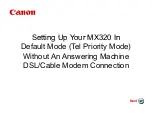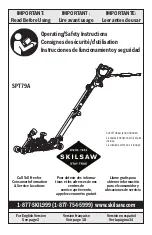
4. Telephone
36
Caller ID
4.6 Caller ID service
This unit is compatible with Caller ID service
offered by your local telephone company. To
use this feature, you must subscribe to Caller
ID service.
Important:
L
This unit is designed in accordance with
the ETS (European Telecommunication
Standard) and only supports the basic
CLIP (Calling Line Identification
Presentation) features.
L
This unit will only display the caller’s
telephone number and name.
L
This unit will not support future additional
telephone services.
L
Depending on the service of the local
telephone company, the date/time of the
call or the caller’s name may not be
displayed.
Make sure the following ring setting is set to
2 or more rings beforehand.
–
TEL/FAX ring setting (feature #78, page 71)
Note:
L
Depending on the service of the local
telephone company, caller information may
not be displayed on the handset in TEL/FAX
mode. In this case, change the TEL/FAX ring
setting to 1 (feature #78 on page 71).
4.6.1 How Caller ID is displayed
When an outside call is received, the calling
party’s telephone number or name will be
displayed. You then have the option of whether
or not to answer the call.
The unit will automatically store caller
information (telephone number, name, date and
time of the call) of the last 30 (base unit)/50
(handset) callers. Caller information is stored by
the most recent to the oldest call. When the 31st
(base unit)/51st (handset) call is received, the
oldest call is deleted.
Caller information can be viewed on the display
one item at a time (page 37) or confirmed by
printing the Caller ID list (page 105).
Note:
L
When caller information is received and it
matches a telephone number stored in the
unit’s phonebook:
–
The stored name will be displayed and
logged.
–
The handset will use the ring tone
assigned to the caller’s category.
L
If the unit is connected to a PBX (Private
Branch Exchange) system, caller information
may not be received properly. Consult your
PBX supplier.
L
If the unit cannot receive caller information,
the following will be displayed:
“
OUT OF AREA
”
: The caller dialled from an
area which does not provide Caller ID
service.
“
PRIVATE CALLER
”
: The caller requested
not to send caller information.
To confirm caller information by printing
the Caller ID list
–
To print manually, see page 105.
–
To print automatically after every 30 new
calls, activate feature #26 (page 69).
Note:
L
Unviewed calls are listed as new.
Call Waiting Caller ID (Handset only)
This is a service of your service provider and will
only operate if you have subscribed to this
service. When you hear a call waiting tone
during a conversation, the display will show the
second caller’s information. You can answer the
second call, keeping the first call on hold. Please
consult your service provider for details of this
service.
Note:
L
The second caller’s information will not be
displayed when:
–
the base unit is in use, or
–
another telephone on the same line is in use.
Category features for handset phonebook
Categories can help you identify who is calling
by using different ring tones for different
categories of callers.
When adding an item to the handset phonebook
you can assign it to the desired category (page
32). When a call is received from a caller
assigned to a category, the category’s ring tone
you select is used.
Changing category ring tones
You can select a ring tone for each category. If
you select
“
Ext. Ringtone
”
, the unit will use
the external ring tone you set on page 76 when
calls from this category are received. The default
setting is
“
Ext. Ringtone
”
.
1.
Press
{k}
, then press
{j
/OK
}
.
2.
Select
“
Category
”
, then press
{>}
.
3.
Select a category, then press
{>}
.
FC235E-PFQX2180YA_en.book Page 36 Monday, June 27, 2005 11:54 AM
Summary of Contents for KX-FC235E
Page 48: ...4 Telephone 46 10 Press ih ...
















































